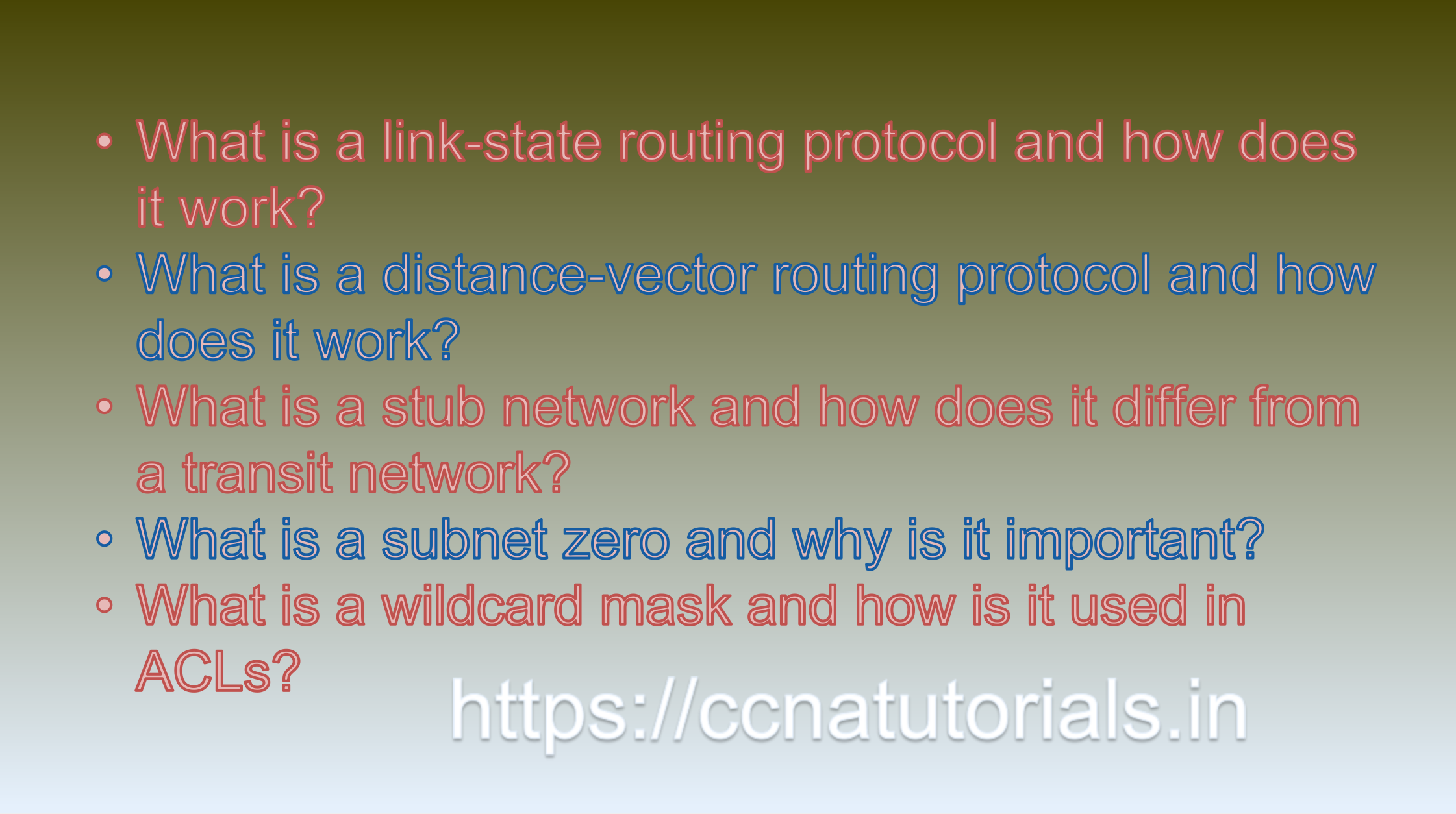Contents of this article
In this article, I describe some CCNA sample questions for practice before appearing in the CCNA 200-301 exam. The following questions are basic questions and related to the CCNA sample questions set 10. There are multiple sample questions set on this website for prior practice online. All questions are described with relevant answers. You can take the following questions and answer as reference for CCNA 200-301 exam. You may also need to do more practice with other websites and books to practice the CCNA sample questions set 10.
Question 1: What is a link-state routing protocol and how does it work?
Link-state routing is a type of routing protocol used in computer networks to determine the best path for network traffic to take. In contrast to distance-vector routing protocols, which rely on simple algorithms and hop counts, link-state routing protocols take a more sophisticated approach by considering the entire network topology and calculating the shortest path to each destination.
Link-state routing protocols work by having each router in the network build a detailed map of the network topology, including all the links between routers, their bandwidth, and their status. This map, called the link-state database, is then used to calculate the best path to each destination based on metrics such as bandwidth, delay, and reliability.
When a link-state router first comes online, it sends out a link-state advertisement (LSA) to all other routers in the network, announcing its own existence and the status of all its connected links. Other routers in the network receive these LSAs, update their own link-state databases, and use the information to calculate the shortest path to each destination.
One of the key advantages of link-state routing protocols is their ability to quickly adapt to changes in the network topology. When a link or router fails, the affected router sends out a new LSA announcing the change, and all other routers in the network update their link-state databases accordingly. This enables the network to quickly converge on a new routing solution that avoids the failed link or router.
Examples of link-state routing protocols include OSPF (Open Shortest Path First) and IS-IS (Intermediate System to Intermediate System). These protocols are commonly used in large enterprise networks and service provider networks where scalability, stability, and fast convergence are critical requirements. This is the answer to question 1 of CCNA sample questions set 10.
Question 2: What is a distance-vector routing protocol and how does it work?
A distance-vector routing protocol is a type of routing protocol used in computer networks to determine the best path for network traffic to take. Unlike link-state routing protocols that take a more sophisticated approach, distance-vector routing protocols use a simpler algorithm based on hop counts and metrics such as delay, cost, or bandwidth to determine the best path to a destination network.
Distance-vector routing protocols work by having each router in the network maintain a routing table that contains the number of hops and the associated cost to reach each destination network. The router periodically sends out its routing table to all its neighboring routers in the network, and each receiving router uses this information to update its own routing table.
The algorithm used by distance-vector routing protocols is called the Bellman-Ford algorithm. The algorithm iteratively calculates the shortest path to each destination network by updating the hop count and cost for each network in the routing table. The router then broadcasts its updated routing table to all its neighbors in the network, and this process continues until the network converges on a stable routing solution.
One of the main advantages of distance-vector routing protocols is their simplicity and ease of implementation. They require less processing power and memory than link-state routing protocols, making them well-suited for small networks. However, distance-vector routing protocols have some limitations, including slower convergence times and less accurate routing decisions compared to link-state routing protocols.
Examples of distance-vector routing protocols include RIP (Routing Information Protocol) and EIGRP (Enhanced Interior Gateway Routing Protocol). These protocols are commonly used in small to medium-sized networks, such as home or small office networks, where simplicity and ease of use are more important than scalability and performance. This is the answer to question 2 of CCNA sample questions set 10.
Question 3: What is a stub network and how does it differ from a transit network?
A stub network is a type of network that has only one route out to another network or the internet. Stub networks are commonly used in small or branch offices that have only one connection to the main network or the internet. In a stub network, all traffic destined for another network or the internet must pass through a single router or gateway.
In contrast, a transit network is a type of network that provides a pathway for data between multiple networks or the internet. Transit networks typically have multiple connections to other networks and act as a hub or intermediary between them. Transit networks are commonly used by service providers or large organizations to connect multiple sites or networks together.
The main difference between a stub network and a transit network is that a stub network has only one route out to another network or the internet, while a transit network has multiple routes and acts as a hub for data traffic. Because of their limited connectivity, stub networks are typically simpler and easier to manage than transit networks, which require more complex routing and management protocols to ensure reliable connectivity. However, transit networks provide greater flexibility and scalability for organizations with multiple sites or networks. This is the answer to question 3 of CCNA sample questions set 10.

Question 4: What is a subnet zero and why is it important?
A subnet zero is the first subnet that can be created from an IP network address range, which includes all addresses from the network address to the first valid host address. In the past, subnet zero was reserved and not used for addressing hosts, but modern networking technologies allow for the use of subnet zero as a valid subnet.
The importance of subnet zero depends on the networking equipment and software being used. Older networking equipment and software may not support subnet zero, and therefore it must be avoided when configuring network addresses and subnet masks. However, modern networking equipment and software support subnet zero and its use can provide benefits such as improved network efficiency and simplified network management.
One benefit of using subnet zero is that it allows for better utilization of IP address space by including the first address of a network as a valid host address. This can be particularly useful in large networks where IP address space may be limited or where addressing scheme flexibility is desired.
In summary, subnet zero is important because it allows for more efficient use of IP address space and can simplify network management, but its use should be carefully considered depending on the networking equipment and software being used. This is the answer to question 4 of CCNA sample questions set 10.
Question 5: What is a wildcard mask and how is it used in ACLs?
A wildcard mask is a type of subnet mask that is used to specify a range of IP addresses in an access control list (ACL). Unlike a subnet mask, which indicates which bits in an IP address represent the network and host portions of the address, a wildcard mask indicates which bits should be matched in an ACL.
In an ACL, a wildcard mask is used to define a range of IP addresses or to exclude specific addresses. For example, a wildcard mask of 0.0.0.255 would match all hosts in the same subnet as the source IP address, while a wildcard mask of 0.0.0.0 would match only the exact source IP address.
Wildcard masks are used with ACLs to control access to network resources. An ACL is a set of rules that specifies which traffic is allowed and which is denied based on the source and destination IP addresses, protocol types, and port numbers. By using a wildcard mask in an ACL, network administrators can specify a range of IP addresses that should be allowed or denied access to a particular resource.
Wildcard masks are commonly used in conjunction with access control lists (ACLs) to control traffic in a network. The use of wildcard masks in ACLs allows for more granular control of network traffic and greater flexibility in defining access control policies. This is the answer to question 5 of CCNA sample questions set 10.
Conclusion for CCNA sample questions set 10
In this article, I described 5 questions with answers related to CCNA 200-301 exam. I hope you found these questions helpful for the practice of the CCNA 200-301 exam. You may drop a comment below or contact us for any queries related to the above questions and answers for CCNA 200-301. Share the above questions If you found them useful. Happy reading!!






